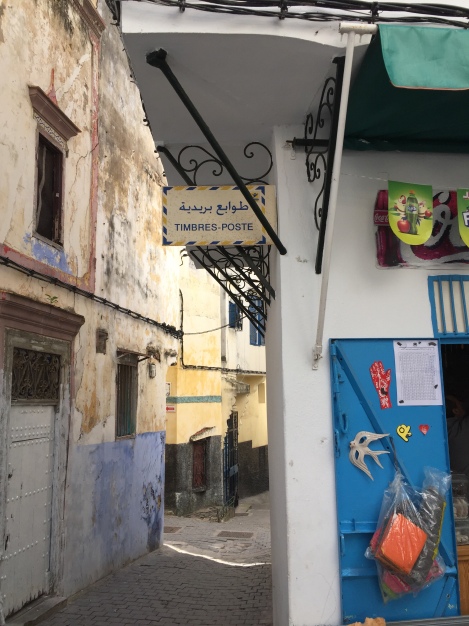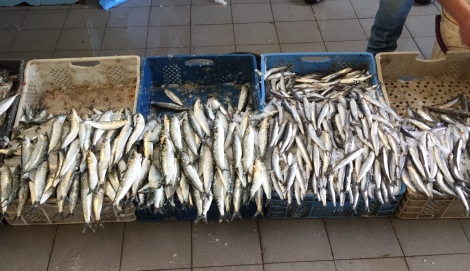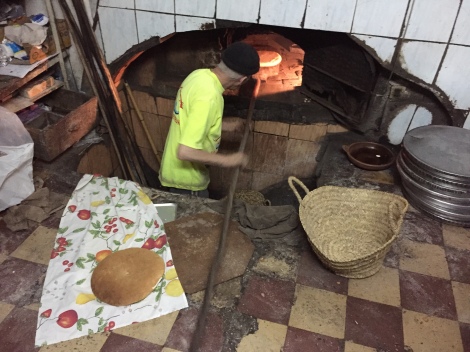Google maps doesn’t work in old medieval cities and Arab souks. Once you’re in the narrow, winding pathways of the markets and residential areas you might as well just go where your spirit (or guide) takes you. At times, there isn’t a soul to be seen…but there’s so much to look at! Colourful, painted walls – ornate doors, flowers, and passageways.



We had two full days to see the city. Not much time, so the night we arrived we asked our hostess at La Tangerina to recommend a guide. The next morning Sharif showed up a few minutes early. He was neatly dressed in western style and prepared to spend the next three or four hours with the three of us. He told us he’d grown up in the old town and would show us places we’d never find on our own. He was true to his word.

Sharif is an optimistic man. He took us back to our hotel a couple of times, to retrieve items, and he never used the same way twice. If I show you the easy way, he said, you’d never need me again! Nonetheless he guided us through the maze of the inner core providing a wealth of historical background and cultural insight.
Our wandering taught us two main rules: If you head down, no matter how labyrinthine the path, you will always end up at the sea. If you head up the hill you will end up at the Casbah (Fort.) Our guesthouse was just inside the casbah wall so we could always find it that way. For most of the journey you may only see a sliver of sky but you always know up is up and down is down.
We visited clothing markets that sell djalabas and beautiful leather shoes. We stopped at stalls selling pottery tagines, and copper pots and pans, fabrics, jewellery.


Tangier is a fishing port too. We’d see the fishermen head out to sea in the early evening. Their catch was for sale the next morning at the market. Some people don’t like the smell of fresh fish, but I find it clean and cool. There is everything from anchovies, to mackerel, shellfish and shrimp, to tuna and swordfish.


Next door is the produce market – a bounty of fruits, vegetables, fresh figs and dates, olives and pickles of all kinds and colours.



And what visit to a Moroccan city would be complete without a visit to a rug dealer! For about an hour we were regaled by an entertaining and persistent vendor who showed us truly beautiful carpets. It was almost impossible to say no but we left him disappointed.
But Sharif also showed us aspects of the city that would have been hard to find on our own,
Most of the residents own their own cell phones, but not everyone has a stove or oven. So they bring their prepared bread doughs, tagines of uncooked meats and pots of stews to communal ovens. There, the cook stores them and then bakes or roasts them over an open wood fire to be ready at the requested time.



At lunch time Sharif entered a small restaurant tucked into a spot inside one of the narrow passages. There was a busy counter with three or four men serving up plates of hummus, rice, chicken, bread and generous bowls of vegetable soup. There was no sign over the door. Sharif explained its name is “The Star” but the sign fell down and hasn’t been replaced. Everyone knows what it is…who needs a sign? He kept reassuring us the place was clean and directed us to wash our hands at the entrance to the cafe. Everyone else was doing it too. Very clean! We would never have gone in on our own. The food was delicious and cheap. But I doubt we’d ever be able to find it again!
The place I loved the most on our tour was an intersection between three small passageways – drenched with reflected sunlight. Sharif stopped and asked us if anything about the place seemed familiar. The tiny square seemed little more than a crossroads with a souvenir shop on one side and a small archway with a dome behind it. He produced a postcard showing a painting by Henri Matisse. The archway with its green accents was glowing in the centre. It was if we were inside the scene! Matisse was one of the many artists and writers drawn to Tangier in the early 20th century. I’m glad we were able to follow in his footsteps.

